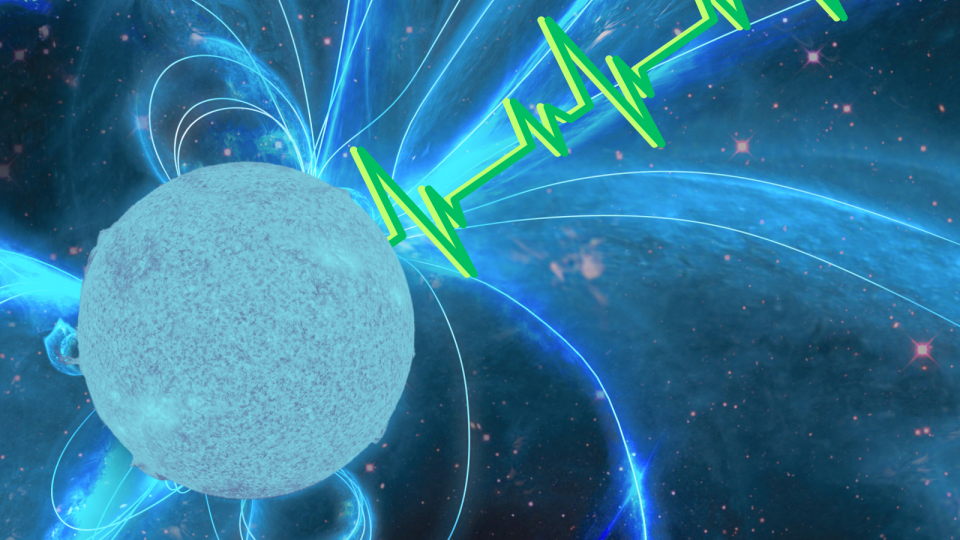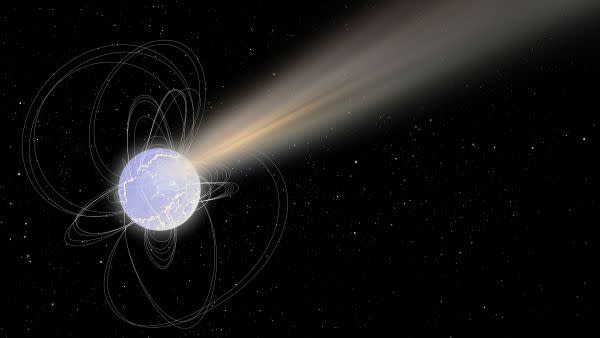When you buy through links on our articles, Future and its syndication partners may earn a commission.


Astronomers have caught a highly magnetic dead star, or “magnetar,” in the Milky Way briefly acting like a pulsar, a type of neutron star that rapidly rotates. The magnetar put on its pulsar disguise after emitting a powerful blast of radiation originally detected in 2020.
The emission is an example of a fast radio burst (FRB), a mysterious blast of energy whose sources and origins are still not well understood. Whereas the majority of FRBs have been traced to sources outside the Milky Way, this one, designated FRB 20200428, originated in our galaxy, making it the first “galactic FRB” ever seen. FRB 20200428 was linked to the highly magnetic neutron star, or “magnetar,” SGR J1935+2154, located around 30,000 light-years away and orbiting the supermassive black hole at the heart of the Milky Way, Sagittarius A* (Sgr A*).
This led many researchers to theorize that FRBs detected from outside the Milky Way also originated from magnetars. The problem was that definitive proof of this connection was missing. Monitoring SGR J1935+2154 further to hunt this “smoking gun,” an international team of researchers discovered the magnetar acting like a rapidly spinning neutron star, or “pulsar,” as it entered a brief “radio pulsar phase” five months after FRB 20200428 was launched.
To investigate this Milky Way magnetar, the team turned to the Five-hundred-meter Aperture Spherical Radio Telescope (FAST) in China, which first uncovered FRB 20200428. This massive radio telescope has a strong history, enabling researchers to hunt for FRBs.
Related: Scientists find slowest spinning ‘radio neutron star’ — it breaks all the dead-star rules
What is interesting about the late pulsar phase of SGR J1935+2154 is that FAST detected it differently than how it detected the magnetar’s FRB blast. That indicated to the team that these two phenomena have different underlying origins.
“FAST detected 795 pulses in 16.5 hours over 13 days from the source,” team leader Weiwei Zhu from the National Astronomical Observatory of China (NAOC) said in a statement. These pulses show different observational properties from the [FRB] bursts observed from the source.”
This difference in “emission modes” between the FRB and the pulses could help astronomers better understand what is launching FRBs both within the Milky Way and at vast cosmological distances. It could also reveal more about neutron stars in their various guises.
Magnetar killed the radio star
Like all neutron stars, magnetars and pulsars are born when a star, at least eight times more massive than the sun, reaches the end of its fuel supply for nuclear fusion. This cuts off the outward flow of energy that supports a star against the inward-crushing push of its own gravity.
Without this outward radiation pressure, the core of the star collapses. This sends shockwaves through the outer material, triggering a massive supernova explosion. As a result of this catastrophic blast, the outer layers of the star are flung away, leaving a rapidly collapsing stellar core with a mass one to two times that of the sun. The product is a neutron star, and the reduction in diameter is dramatic.
All neutron stars are estimated to have diameters of around 12 miles (20 kilometers), meaning they would comfortably sit in some major cities here on Earth. The effects of this would be anything but comfortable, though.
Containing up to twice the mass of the sun in a sphere as wide as Manhattan Island is long. neutron stars are made of a unique form of incredibly dense matter that is rich in neutrons, particles normally locked up with protons in the nuclei of atoms. If one sugar-cube-sized sample of this matter were scooped from a neutron star and brought to Earth, it would weigh an astonishing 1 billion tons. That is over twice the weight of the entire human race, estimated to be 390 million tons.
This isn’t the only extreme characteristic of a neutron star, however.


Because of the conservation of angular momentum, when the diameter of a freshly born neutron star is rapidly reduced, the speed at which it spins gets a massive boost.
A very Earthly example of this can be seen in ice skating. When an ice skater wants to increase the speed of their spin, they draw in their arms. To then slow this spin, they spread their arms back out.
Pulsars are neutron stars that can spin so fast that they complete hundreds of rotations every second. In fact, the fastest-spinning pulsar ever detected is PSR J1748−2446ad, which spins 716 times a second. A pulsar also blasts beams of radiation from its poles. That means, as it spins, this type of neutron star sweeps beams of radiation across the universe like a cosmic lighthouse.
The reduction in width of neutron stars also pushes together the magnetic field lines of the progenitor star. The closer together magnetic field lines are, the stronger the magnetic field lines become. This means neutron stars have the most powerful magnetic fields in the universe, with some reaching over 1 billion Tesla. For comparison, the most powerful magnetic fields generated here on Earth are around 1,500 Tesla. The neutron stars with the most powerful magnetic fields are called magnetars.
To be clear, all magnetars are neutron stars, and all pulsars are neutron stars, but magnetars are different from pulsars because they usually lack the beams of radiowaves from their poles that make them appear to pulse. Magnetars aren’t emission-free, though; they have long been cited as the source of FRBs.


When a magnetar mimics a pulsar
Radio pulses like those detected by the team during the late pulsar phase of SGR J1935+2154 are similar to FRBs, but the latter emissions are tens of billions of times brighter. They are also common to pulsars, as mentioned above, but not so much to magnetars. Most magnetars don’t emit pulses of radio waves, possibly because their intense magnetic fields prevent them from doing so.
Despite this, some magnetars can briefly become pulsars after they undergo a bout of bursting activity. That seems to be what Zhang and the team observed with SGR J1935+2154.
“Like pulses in radio pulsars, the magnetar pulses are emitted within a narrow phase window within the period,” Zhang explained. “This is the well-known ‘lighthouse’ effect, namely, the emission beam sweeps the line of sight once a period and only during a short interval in time in each period. One can then observe the pulsed radio emission.”
When FRB 20200428 was detected from the same magnetar in April 2020, this FRB and several less energetic bursts that trailed it were random. That means they weren’t part of the precise frequency pulse window of SGR J1935+2154’s pulsar phase.
“This strongly suggests that pulses and bursts originate from different locations within the magnetar magnetosphere, suggesting possibly different emission mechanisms between pulses and bursts,” Zhang continued.
Related Stories:
— NASA X-ray telescope ‘weighs’ the closest rapidly spinning dead star to Earth
— New kind of pulsar may explain how mysterious ‘black widow’ systems evolve
— Hear ‘black widow’ pulsar’s song as it destroys companion
One possible outcome of this investigation and its follow-up is a better understanding of why some FRBs repeat while most do not.
FAST has detected thousands of repeated FRBs from the same sources, probably magnetars. However, unlike the pulses of pulsars, these repeating FRBs have lacked a clear pattern, or “periodicity.” This has cast doubt on the belief FRBs originate from magnetars.
That is doubt this research could clear up.
“Our discovery that bursts tend to be generated in random phases provides a natural interpretation to the non-detection of periodicity from repeating FRBs,” Zhang concluded. “For unknown reasons, bursts tend to be emitted in all directions from a magnetar, making it impossible to identify periods from FRB sources.”
The team’s research was published on July 28 in the journal Science Advances.
